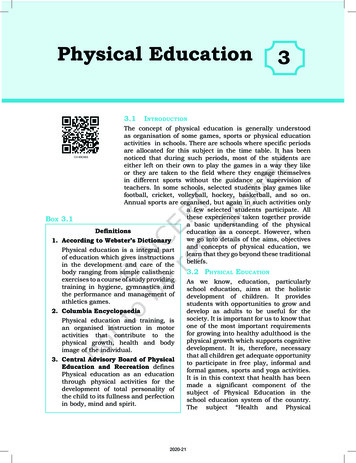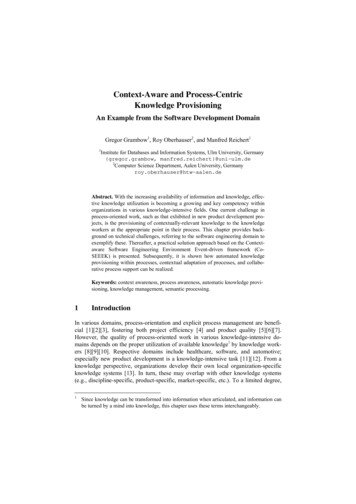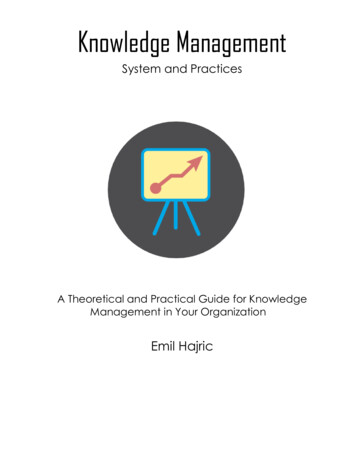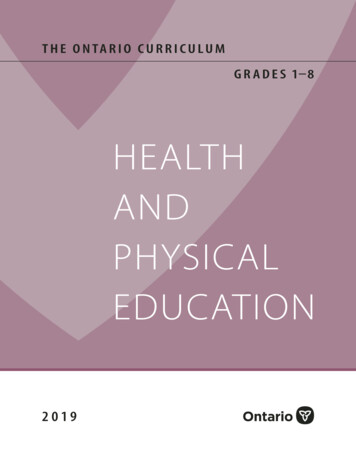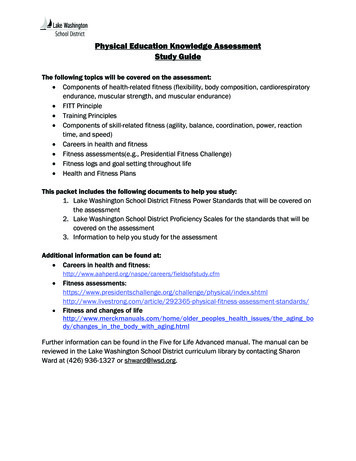
Transcription
Physical Education Knowledge AssessmentStudy GuideThe following topics will be covered on the assessment:Components of health-related fitness (flexibility, body composition, cardiorespiratoryendurance, muscular strength, and muscular endurance)FITT PrincipleTraining PrinciplesComponents of skill-related fitness (agility, balance, coordination, power, reactiontime, and speed)Careers in health and fitnessFitness assessments(e.g., Presidential Fitness Challenge)Fitness logs and goal setting throughout lifeHealth and Fitness PlansThis packet includes the following documents to help you study:1. Lake Washington School District Fitness Power Standards that will be covered onthe assessment2. Lake Washington School District Proficiency Scales for the standards that will becovered on the assessment3. Information to help you study for the assessmentAdditional information can be found at:Careers in health and sofstudy.cfmFitness ndards/Fitness and changes of lifehttp://www.merckmanuals.com/home/older peoples health issues/the aging body/changes in the body with aging.htmlFurther information can be found in the Five for Life Advanced manual. The manual can bereviewed in the Lake Washington School District curriculum library by contacting SharonWard at (426) 936-1327 or shward@lwsd.org.
Fitness Level II Power Standards3. Understands the components of health-related fitness and interprets information from feedback, evaluation,and self-assessment in order to improve performance.4. Understands the components of skill-related fitness and interprets information from feedback, evaluation,and self-assessment in order to improve performance.5. Analyzes personal fitness information to develop and monitor a fitness plan.Please note: Power standards 1 and 2 are movement standards so will not be assessed on the FitnessKnowledge Assessment. Lake Washington School District1
Proficiency Scales Fitness IIPower Standard 3: Understands the components of health-related fitness and interprets information from feedback,evaluation, and self-assessment in order to improve performance.Score DescriptorProficiency ScaleTransfer of learning to more complex content and thinking (not new content), including deeper conceptualunderstanding and applications that go beyond what is explicitly taught in class.4ExceedsStandardCompares and contrasts Health-related Fitness Programs (e.g., Presidential Physical Fitness,Physical Best, Fitness Gram).Researches the outcome of a personal health and fitness plan based on long-term individualprogress (e.g., speculate the results of a consistently followed fitness program).The standard/learning target: content, details, vocabulary, concepts, procedures, processes, and skills (simple andcomplex) explicitly taught in class.Understands the components of health-related fitness and interprets information from feedback,evaluation, and self-assessment in order to improve performance.Analyzes the components of health-related fitness.Draws conclusions from the components of health–related fitness in setting fitness goals (e.g.,understands how to improve cardiorespiratory endurance by increasing frequency of cardioworkout).3At StandardAnalyzes the progress of a personal health and fitness plan.Compares and contrasts personal progress in relationship to national physical fitnessstandards (e.g., compares personal mile time to national physical fitness standards).Integrates various personal monitoring systems that assess the components of health-relatedfitness in relation to the FITT Principle (e.g., understands FITT Principle for cardiorespiratoryendurance: F 3 to 5 times per week, I 60 – 85% target heart rate, T 20 – 30 minutes, T Running).Integrates training principles and phases of a workout to a health and fitness plan (e.g., usesthe progression of training principle to gradually increase heart rate to prepare the body foractivity, in the warm-up phase of a workout).Draws conclusions of the effectiveness of a health and fitness plan and suggests ways torealign goals.Simpler content, details, vocabulary, procedures, processes, and skills, including foundational knowledge andconcepts, explicitly taught in class.2ApproachingStandard1Not AtStandardDefines the components of health-related fitness (cardiorespiratory endurance, muscularstrength, muscular endurance, flexibility, and body composition).Recalls the four components of the FITT Principle.Recalls the healthy level of fat mass for males and females.Recalls the benefits of improving each component of health-related fitness.Identifies training principles.Records the progress of a health-related fitness plan (e.g., identifies the fitness componentwithin the health-related fitness plan).With help, partial understanding of some of the simpler and more complex content, details, vocabulary, concepts,procedures, processes, and skills.Curriculum, Assessment and Instruction Framework Fitness II Proficiency Scales Lake Washington School District January 2013
Proficiency Scales Fitness IIPower Standard 4: Understands the components of skill-related fitness and interprets information from feedback,evaluation, and self-assessment in order to improve performance.Score DescriptorProficiency ScaleTransfer of learning to more complex content and thinking (not new content), including deeper conceptualunderstanding and applications that go beyond what is explicitly taught in class.4ExceedsStandardAnalyzes the skill-related fitness components of a highly skilled performer to enhance personalperformance (e.g., power; vertical jump of a basketball player).Compares and contrasts the skill-related fitness components involved in at least 3 differenttypes of movement forms.Creates a plan to reach a goal which includes both skill-related and health-related fitnesscomponents.Compares and contrasts the components of skill-related fitness needed for variouscareers/occupations/recreation.The standard/learning target: content, details, vocabulary, concepts, procedures, processes, and skills (simple andcomplex) explicitly taught in class.Understands the components of skill-related fitness and interprets information from feedback,evaluation, and self-assessment in order to improve performance.3At StandardApplies the components of skill-related fitness through physical activity.Predicts skill-related fitness in a physical activity (e.g., understands how agility, balance,coordination, power, reaction time, and speed are used in the game of ultimate Frisbee).Applies components of skill-related fitness in a health and fitness plan (e.g., Agility – shuttlerun, Balance – balance board, Coordination – juggling, Power – standing long jump, Reactiontime – yardstick drop, Speed – short sprint).Applies components of skill–related fitness in at least two of the following different types ofmovement forms: Aquatics, individual activities, team sports/activities, outdoor pursuits, selfdefense, and dance (e.g., shows agility in volleyball. Shows power when diving in aquatics).Shows correlation between components of skill-related fitness and components of healthrelated fitness as it relates to overall fitness and physical performance (e.g., explains howbalance and cardiorespiratory endurance is needed in long distance running).Analyzes components of skill-related fitness as related to careers/occupations/recreation.Integrates components of skill-related fitness as it relates to occupations, careers, andrecreation (e.g., analyzes occupations that require balance (construction working walking onscaffolding)).Simpler content, details, vocabulary, procedures, processes, and skills, including foundational knowledge andconcepts, explicitly taught in class.2ApproachingStandard1Not AtStandardIdentifies the component needed in skill-related fitness activities (e.g., Agility – shuttle run,Balance – balance board, Coordination – juggling, Power – standing long jump, Reaction time– yardstick drop, Speed – short sprint.)Observes and identifies the skill-related fitness component in one activity.Identifies the skill-related fitness component in a sport activity (e.g., power in a basketballjump shot).Labels a skill-related fitness component as it relates to one career (e.g., surgeon,coordination).With help, partial understanding of some of the simpler and more complex content, details, vocabulary, concepts,procedures, processes, and skills.Curriculum, Assessment and Instruction Framework Fitness II Proficiency Scales Lake Washington School District January 2013
Proficiency Scales Fitness IIPower Standard 5: Analyzes personal fitness information to develop and monitor a fitness plan.Score DescriptorProficiency ScaleTransfer of learning to more complex content and thinking (not new content), including deeper conceptualunderstanding and applications that go beyond what is explicitly taught in class.4ExceedsStandardAnalyzes an individual’s fitness level and constructs an appropriate fitness plan given theirpersonal fitness goals.Designs a career plan of interest in the health or fitness area.Formulates a plan related to a life changing event to include recovery.Adjusts goals meeting fitness needs as life changes occur (recovery of knee surgery).Designs a program that includes training for a variety of physical activities.Speculates the results from building a timeline related to a specific fitness goal.The standard/learning target: content, concepts, and/or processes/skills (simple or complex) which were explicitlytaught in class.Analyzes personal fitness information to develop and monitor a fitness plan.Analyzes daily fitness habits and career opportunities in fitness:Analyzes a personal fitness plan, critiquing individual health behaviors (e.g., diet, sleep,activity, and fitness).Sets goals for daily fitness improvement.Compares and contrasts various career opportunities in health and fitness.3At StandardEvaluates concepts of health, fitness, based on life and employment goals.Chooses appropriate goal setting strategies in creating a personal health and fitness plan.Chooses time-management skills in creating a personal health and fitness plan.Selects and participates in a variety of physical activities.Selects health, fitness, and nutrition concepts in developing and implementing a personalhealth and fitness plan, based on personal interests and life goals.Chooses a short and long-term monitoring system for a personal health and fitness plan.Evaluates goals to make a new personal health and fitness plan as health/fitness/life changesoccur (e.g., updates health and fitness goals in a personal health and fitness plan throughoutthe lifespan).Understands barriers to physical activity and a healthy lifestyle.Describes barriers to physical activity and promotes strategies to overcome them (e.g.;recognizes barriers to physical activity may include knee surgery; strategies would includerehabilitation/physical therapy).The standard/learning target: content, details, vocabulary, concepts, procedures, processes, and skills (simple andcomplex) explicitly taught in class.2ApproachingStandard1Not AtStandardIdentifies a general personal fitness goal (e.g.; lose weight, get stronger).Identifies a variety of career options within the Health and Fitness field.Identifies goal setting strategies.Identifies time-management skills.Identifies short-term and long-term monitoring systems for a personal health and fitness plan.Identifies changes that occur in life that would require modifications in a fitness goal or plan(e.g., bone density decreasing as a person ages, injuries)With help, partial understanding of some of the simpler and more complex content, details, vocabulary, concepts,procedures, processes, and skills.Curriculum, Assessment and Instruction Framework Fitness II Proficiency Scales Lake Washington School District January 2013
FIVE FOR LIFEUnderstanding
cardiorespiratory
endurance,
muscular
strength,
muscular
endurance,
flexibility
and body composition,
known
as
the
Five Components of Fitness, is important for improving health,performance and appearance.Cardiorespiratory endurance is the ability of the heart, blood, blood vessels and lungs to supply enoughoxygen
and
necessary
fuel
to
the
muscles
during
long
periods
of
physical
activity.
Participating
in
aerobic
activities
is
the
best
way
to
improve
cardiorespiratory
endurance
because
they
require
the
body
to
use
large
amounts of oxygen for sustained periods of time. With
the
increased
need
for
oxygen,
the
heart
must
beat
faster
to
pump
more
blood
throughout
the
body.
In
turn,
over
time,
the
heart,
which
is
a
muscle,
will
become
stronger
and
will
be
able
to
pump
more
blood
with
each
beat,
therefore,
beating
at
a
slower
rate
while
circulating
the
same
amount
of
blood.
This
increased
ef ficiency
enables
a
person
to
work,
exercise
and
play
more
often
and
more
vigorously
for
longer
periods
of
time
without
getting
tired.
Training to improve cardiorespiratory endurance also improves appearance by toning the body and reducingbody
fat,
which
helps
to
improve
body
composition.
As
personal
appearance
improves,
a
sense
of
well- being
and a positive self-image is created.Muscular strength
is
the
ability
of
muscles
to
push
or
pull
with
total
force.
Increasing
muscular
strength
allows
a
person
to
lift,
push,
or
pull
with
more
force.
This
is
a
bene fit
in
any
athletic
situation,
but
it
is
also
important
for
other
life
situations
like
when
the
car
has
a
flat
tire
or
when
the
door
is
stuck.
Muscular endurance
is
the
ability
of
muscles
to
repeat
a
movement
many
times
or
to
hold
a
position
without
stopping
to
rest.
Improving
muscular
endurance
allows
a
person
to
increase
physical
activity.
A
person
with
improved
muscular
endurance
can
accomplish
more
physical
work
by
moving
longer
and
taking
fewer
breaks.
Muscular
strength
comes
before
muscular
endurance.
Before
the
brick
layer
can
stack
hundreds
of
bricks
a
day,
he/she
must
have
the
muscular
strength
to
lift
the
first
brick.
Once
he/she
has
the
initial
strength
to
lift
the
first
brick,
the
brick
layer
can
begin
to
build
muscular
endurance.One
of
the
best
ways
to
build
muscular
strength
and
muscular endurance is through resistance training, oractivities that place an additional force against the muscle or muscle group. Some examples of resistancetraining
include
weight
training,
push- ups
and
crunches.
Muscles
react
positively
to
strenuous
activity
and
negatively
to
inactivity.
Therefore,
the
old
adage,
“Use
them
or
lose
them”,
is
true.
When
the
body
is
inactive,
a
large
percentage
of
strength
is
lost
over
time.
Likewise,
asthe
body
ages
bone
density
tends
to
decrease
which
can
lead
to
weak
bones
(osteoporosis).
While
resistance
training,
along
with
engaging
in
an
active
lifestyle,
improves
muscular
strength
and
muscular
endurance,
it
also
can improve bone density. Therefore, building
muscle
provides
health
bene fits
that
can
last
throughout
life.Physical
performance
will
also
be
enhanced
through
the
development
of
muscular
strength
and
muscular
endurance.
As
muscles
become
stronger
and
gain
endurance,
a
person
will
be
able
to
to
work,
exercise
or
play
more
often,
with
more
power
and
for
longer
periods
of
time.
2008 Focused Fitness All rights reserved.1.4
FIVE FOR LIFEResistance training to develop muscular strength and muscular endurance also helps improve physicalappearance by controlling body composition. As resistance training increases muscle mass, a part of fat-freemass,
fat
mass
decreases.
Because
muscles
use
calories
to
work,
the
more
muscle
mass
a
person
has,
the
more
calories
that
will
be
used.
Using
more
calories
reduces
the
number
of
calories
stored
as
fat
mass.
Therefore, building muscular strength and muscular endurance is a lifelong habit needed to maintain orimprove physical appearance.Flexibility
is
the
muscles’
ability
to
move
a
joint
through
a
full
range
of
motion,
and
staying
flexible
is
important to health and performance. As the body ages, the muscles, tendons and ligaments stiffen, loseelasticity
and
become
less
flexible.
As
a
result,
a
person’s
ability
to
perform
movements
may
be
hindered
and
he/she
may
be
at
an
increased
risk
of
injury.
Improving
flexibility
decreases
a
person’s
risk
of
injury,
prevents
post-exercise pain and helps relieve emotional tension.Daily
activities
such
as
combing
hair,
tying
shoes
and
participating
in
athletics
require
flexibility.
Golfers
need
flexibility
in
the
hips
and
shoulders
to
allow
them
to
rotate
the
golf
club
farther
and
in
turn
hit
the
ball
a
greater
distance.
Softball
and
baseball
players
need
flexibility
in
their
shoulders
and
arms
so
that
they
can
bring
the
ball
back
farther,
which
allows
them
to
throw
the
ball
harder.
Flexibility
is
required
for
everyday
movements,
from
tying
shoes
to
throwing
a
ball.
If
a
person
does
not
perform
activities
that
improve
flexibility,
then
one
day
he/she
may
not
be
able
to
perform
those
activities.
Therefore,
activities
to
improve
flexibility
should
be
performed
daily,
Dynamic
and
static
stretches
are
safe
and
effective
methods
to
improve
flexibility.
Dynamic stretchesinvolve
moving
parts
of
the
body
continuously
while
gradually
increasing
reach,
speed
of
movement
or
both
gently throughout a full range of motion. Static stretches involve stretching a muscle to the point of milddiscomfort
for
an
extended
period
of
time.
These
stretches
can
be
performed
as
part
of
the
warm- up
and/or
cool
down
phases
of
a
fitness
program
or
as
a
separate
flexibility
program.
Body Composition is the combination of fat mass and fat-free mass, including fat, bones, muscles, organs,and
water.
Healthy
levels
of
fat
mass
are
essential
for
insulation,
the
protection
of
organs,
the
absorption
of
vitamins,
nerve
conduction
and
as
an
energy
source.
Having
too
much
or
too
little
fat
mass
can
become
a
health
risk,
lower
performance
and
detract
from
appearance.
Therefore,
body
composition
is
usually
referred
to as a percentage of body fat.A
healthy
level
of
fat
mass
for
men
is
between
10%
and
20%
of
total
body
weight
and
a
healthy
level
of
fat
mass
for
women
is
between
15%
and
25%
of
total
body
weight.
Improving
and
maintaining
body
composition
at
healthy
levels
will
reduce
the
risk
of
heart
disease,
Type
2
diabetes,
high
blood
pressure,
strokes,
certain
types of cancer and obesity.The
percentage
of
fat
a
person
has
is
affected
by
two
factors;
the
number
of
calories
consumed
(energy
in)
and the amount of activity performed and calories used (energy out). Both of these factors are controllable.A combined effort of eating a healthy diet (energy in) and increasing physical activity (energy out) is the bestapproach to maintaining a healthy level of body fat and improving overall body composition.The
bene fit
of
understanding
cardiorespiratory
endurance,
muscular
strength,
muscular
endurance,
flexibility
and
body
composition,
known
as
the
Five
Components
of
Fitness,
is
immeasurable
and
is
important
for
improving health, performance and appearance for a lifetime. 2008 Focused Fitness All rights reserved.1.5
FIVE FOR LIFEKey
vocabulary
words
that
will
be
introduced
during
this
unit
are:
Body Composition – The combination of fat mass and fat-free mass, including fat,bones,
muscles,
organs,
and
water
Cardiorespiratory Endurance – The ability of the heart, blood, blood vessels and lungsto supply oxygen to the muscles during long periods of physical activity
Flexibility – The muscles’ ability to move a joint through a full range of motion
Muscular Endurance – The ability of the muscles to repeat a movement many times orhold
a
position
without
stopping
to
rest
Muscular Strength
–
The
ability
of
a
muscle
or
muscles
to
push
or
pull
with
its
total
force
Static Stretches
–
Involves
stretching
a
muscle
to
the
point
of
mild
discomfort
for
an
extended period of time.
Dynamic Stretches – Involves
moving
parts
of
the
body
continuously
while
gradually
increasing reach, speed of movement or both gently through a full range of motion.
Resistance Training – An activity that places an additional force against the muscle ormuscle group. 2008 Focused Fitness All rights reserved.1.6
Training PrinciplesAdopted from the Five for Life curricular materialsWhen developing and implementing a personal fitness plan, it is important to understand the training principles:overload, progression, specificity, and rest and recovery. Understanding the training principles and how to applythose principles increases a person’s ability to develop a fitness plan to meet personal goals toward improvedhealth, performance and appearance. It also increases their ability to adjust those plans as necessary. A wellthought out training program uses the FITT Principle to produce overload and includes progression, specificity aswell as rest and recovery.The training principles are used to help individuals achieve exercise goals in many different careers. Since thebeginning of athletic competition, the principles of training have been used to improve performance. Strengthcoaches use them to design workout programs for top athletes. Two-tenths of a second in the hundred meter dashor two inches in the high jump might be the difference between being a good college athlete and an Olympian. OneOlympic athlete reported that he trained for eight years to take 1.5 seconds off his 200 meter time. Thatimprovement in time was the difference between being a good high school sprinter and an Olympic champion with aworld record. Personal trainers use the training principles to help movie stars lose weight or bulk up as they preparefor roles in upcoming movies. Firefighters and police officers use these principles to maintain their fitness in order toperform their jobs.The FITT Principle is a set of guidelines that help set up a workout routine to help get the most out of the exerciseprogram. FITT stands for: frequency (how often you exercise), intensity (how hard you work during exercise), time(how long you exercise or how many repetitions you complete), and type (what type of exercise you are doing). Forpositive changes to occur in health, performance and appearance, the body must adapt to an increased demand inone of three variables of the FITT Principle. Increasing the frequency, intensity or time (FITT Principle) of an activitybeyond normal performance provides a reason for the body to adapt or change to meet the new demand and makepositive changes in health, performance, and appearance. Training the body beyond normal performancedemonstrates the principle of overload.For example, to improve cardiorespiratory endurance, a person who runs a ten-minute mile three times a week couldcreate overload by changing the frequency of his/her workouts from three to four times per week, increasing theintensity by running at a faster pace that a ten-minute mile, or increasing the time by running at the same pace butfor a longer distance. Each of these changes would create an overload by placing a demand on the body beyondnormal performance.With overload, the body adapts slowly and makes small changes toward improvement over time. Therefore, it isimportant to use the principle of progression correctly. It would be unreasonable to expect the person who ran a tenminute mile three times a week, to increase all three FITT variables at once. Because the body requires periods ofrest, running eight-minute miles five days a week would be difficult. The drastic difference in overload could lead toexhaustion or injury, causing the body to break down rather than adapt, thus preventing progression. To achievedesired results, the principle of progression, or gradually increasing frequency, intensity or time to create overloadmust be applied correctly, allowing the body to make subtle changes gradually over time.Most athletes know that getting enough rest after exercise is essential to high-level performance, but many still overtrain and feel guilty when they take a day off. The body repairs and strengthens itself in the time between workouts,and continuous training can actually weaken the strongest athletes. Therefore, it is essential to incorporate theprinciple of rest and recovery into a workout schedule. Building recovery time into any training program is importantbecause this is the time that the body adapts to the stress of exercise and the real training effect takes place.Recovery also allows the body to replenish energy stores and repair damaged tissues. Exercise, or any other physicalwork, causes changes in the body such as muscle tissue breakdown and the depletion of energy stores (muscle
glycogen), as well as fluid loss. Recovery time allows these stores to be replenished and allows tissue repair tooccur. Without sufficient time to repair and replenish, the body will continue to break down from intensive exercise.That is why is suggested that people work any muscle group between three and five times a week.Besides overload, progression, and rest and recovery, it is important to consider the principle of specificity whendesigning a fitness plan to improve health, performance and appearance. The principle of specificity states thattraining is specific to the muscles used and the component of fitness
Analyzes personal fitness information to develop and monitor a fitness plan. Analyzes daily fitness habits and career opportunities in fitness: x Analyzes a personal fitness plan, critiquing indivi
